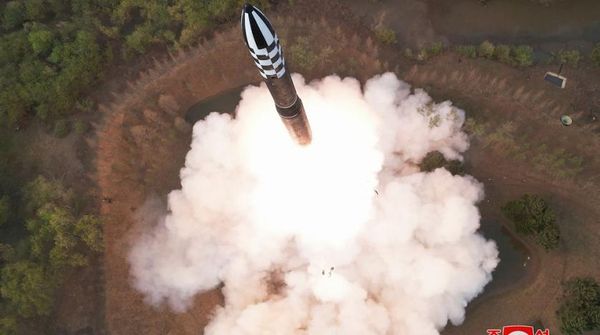
North Korea claims it has successfully tested a solid-fuel intercontinental ballistic missile (ICBM) for the first time – a breakthrough that the country’s leader, Kim Jong-un, warned would make its enemies “suffer in endless fear”.
South Korea’s military said it had detected the launch on Thursday morning of one “medium-range or longer” ballistic missile on an elevated trajectory from near the North Korean capital Pyongyang.
The US National Security Council described it as a long-range missile, while Japan’s government said it likely had an intercontinental range.
The missile flew upwards at a steep angle – apparently to reduce the risk of it accidentally striking neighbouring countries – and is believed to have covered a distance of 1,000km (620 miles), although experts say that, flown at a regular trajectory, it could cover much longer distances.
North Korean state media said the regime had tested a “new type of intercontinental ballistic missile” called the Hwasung-18. Its predecessor, the liquid-fuelled Hwasung-17, which the regime tested in March, has an operational range of 15,000km – far enough to reach the US mainland.
Thursday’s launch triggered a scare in northern Japan, where Hokkaido residents were told to take cover, though there turned out to be no danger.
“The test proved … the new intercontinental ballistic missile’s military efficiency as a strategic attack capability,” the North’s official KCNA news agency said.
Kim said the new weapon would “greatly reorganise our strategic deterrence and reinforce effectiveness of our nuclear counterattack”, according to KCNA.
“We will strike with deadly force and respond aggressively until the enemy gives up its idle strategy and foolish behaviour and so that it will suffer in endless fear.”
KCNA released photos of Kim watching the launch, accompanied by his wife, sister and daughter, with the missile covered in camouflage nets on a mobile launcher.
Kim has long pushed for the development of solid-fuel ICBMs that can be launched from land or submarines. Missiles that use liquid propellants must be fuelled just prior to launch, but those that use solid-propellant are fuelled when they are manufactured, making them easier to transport and cutting the time it takes to prepare them for launch.
Those capabilities make them harder to detect and destroy in a pre-emptive strike.

North Korea showed off a record number of nuclear and ICBMs at a military parade in Pyongyang in February, including what analysts said was possibly a new solid-fuel ICBM.
“The reason North Korea is obsessed about solid-fuel missiles is because it will significantly reduce the preparation time before launch,” said Go Myong-hyun, a researcher at the Asan Institute for Policy Studies in Seoul.
“This is important as the longer it takes after bringing out the missile from a silo or a tunnel, the higher the possibility of destruction before launch.”
South Korea’s defence ministry challenged North Korean claims that it had perfected a solid-fuel ICBM, saying on Friday that the regime would need more time to master the technology.
The ministry also maintains that the North has yet to reach the point where it can protect its ICBM warheads during re-entry into the atmosphere. The defence minister, Lee Jong-Sup, told lawmakers last month that the North was unlikely to have mastered the technology needed to place nuclear warheads on its most advanced short-range missiles, although he acknowledged that the regime was making “considerable progress”.
The latest launch came days after Kim called for strengthening the country’s war deterrence in a “more practical and offensive” manner to counter what North Korea called aggressive moves by the US.
North Korea has criticised recent US-South Korean joint military exercises as as a rehearsal for an invasion, while Washington and Seoul insist they are purely defensive. The drills, along with North Korean weapons tests, have significantly raised tensions on the peninsula in recent months.
The ICBM claims come just before North Korea is set to mark one of its most important political anniversaries, the Day of the Sun, on Saturday.
The date commemorates founding leader Kim Il-sung’s birth anniversary and has typically been marked by significant weapons tests or military parades.
With Reuters and Agence France-Presse










